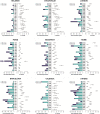The inter-annual variability of heat-related mortality in nine European cities (1990-2010)
- PMID: 30089503
- PMCID: PMC6083580
- DOI: 10.1186/s12940-018-0411-0
The inter-annual variability of heat-related mortality in nine European cities (1990-2010)
Abstract
Background: The association between heat and daily mortality and its temporal variation are well known. However, few studies have analyzed the inter-annual variations in both the risk estimates and impacts of heat. The aim is to estimate inter-annual variations in the effect of heat for a fixed temperature range, on mortality in 9 European cities included in the PHASE (Public Health Adaptation Strategies to Extreme weather events) project for the period 1990-2010. The second aim is to evaluate overall summer effects and heat-attributable deaths for each year included in the study period, considering the entire air temperature range (both mild and extreme temperatures).
Methods: A city-specific daily time-series analysis was performed, using a generalized additive Poisson regression model, restricted to the warm season (April-September). To study the temporal variation for a fixed air temperature range, a Bayesian Change Point analysis was applied to the relative risks of mortality for a 2 °C increase over the 90th percentile of the city-specific distribution. The number of heat attributable deaths in each summer were also calculated for mild (reference to 95th percentile) and extreme heat (95th percentile to maximum value).
Results: A decline in the effects of heat over time was observed in Athens and Rome when considering a fixed interval, while an increase in effects was observed in Helsinki. The greatest impact of heat in terms of attributable deaths was observed in the Mediterranean cities (Athens, Barcelona and Rome) for extreme air temperatures. In the other cities the impact was mostly related to extreme years with 2003 as a record breaking year in Paris (+ 1900 deaths) and London (+ 1200 deaths).
Conclusions: Monitoring the impact of heat over time is important to identify changes in population vulnerability and evaluate adaptation measures.
Keywords: Attributable risk; Bayesian models; Heat; Mortality; Temporal trends; Time factors.
Conflict of interest statement
Not applicable
Not applicable
The authors declare that they have no competing interests.
Springer Nature remains neutral with regard to jurisdictional claims in published maps and institutional affiliations.
Figures



References
-
- Baccini M, Biggeri A, Accetta G, Kosatsky T, Katsouyanni K, Analitis A, et al. Heat effects on mortality in 15 European cities. Epidemiology. 2008; - PubMed
-
- de’Donato FK, Leone M, Scortichini M, De Sario M, Katsouyanni K, Lanki T, et al. Changes in the Effect of Heat on Mortality in the Last 20 Years in Nine European Cities. Results from the PHASE Project. Int J Environ Res Public Health. 2015;12:15567–15583. doi: 10.3390/ijerph121215006. - DOI - PMC - PubMed
Publication types
MeSH terms
Grants and funding
LinkOut - more resources
Full Text Sources
Other Literature Sources
Miscellaneous

